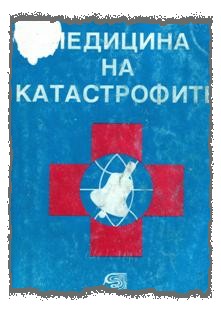
DISASTER MEDICINE
Author: Vessela Popzaharieva

The subject of disaster medicine has rather late emergence in the curriculum of medical education, hence its unifying role for large number of branches and sub-disciplines in the public health domain that have been long time debating on the conceptual entity of hazards and risks. Ultimately, the field exists on the premises to foster collaboration in the application of data collected through qualitative and quantitative research to the development of strategies promoting all aspects of human health, decreasing susceptibility and increasing resilience to future health disasters and emergencies. As simple as that, we remain faithful to our aim to present peculiar and little known facts from the scientific reality in Bulgaria. Disaster medicine is such under-developed field and deserved our attention with this small review.
This textbook whatsoever is a collective effort from group of specialists working in seemingly unrelated branches at health sciences, but really it is a first attempt to present body of material on such topics as - viz., i./ natural hazards with exponent to earthquakes, flooding, foresting fires, etc; ii./ radiological hazards pertaining to termonuclear crashes of various magnitude and source; iii./ chemical toxicology due to exceptional leakages of poisonous material on human habitats and dwellings; iv./ war conflicts with particular attention to tactical defense of civil population and distribution of humanitarian aid; v./ large scale epidemiological and/or other mass communal afflictions of undetermined character, like MUPS (i.e., medically unexplained symptoms) and others. We could continue our list of enumeration and expand some methodological considerations, however this is not subject to our presentation. Besides there is enough material available in english textbooks and allied sources on the Net.
In historical aspect and it is difficult to outline a consistent chronology of this special branch of medicine, furthermore it didn't have a special departmental structure until year 1981. The medical discipline persisted in various forms, most notably in the premises of military hygiene and Red Cross activities before WWII. From that period we have information on several scientific courses for first aid in case of mass disasters, but nothing special as centralized educational effort. After communist reconstruction there was a flourishing of the idea of medico-sanitary defense within organizational structures of Medical University, Sofia. There was a special branch associated to the Ministry of Health and later to the Institute for Postgraduate Studies /i.e., ISUL with transliteration from bulgarian language/ - viz., this so called "Department 22" was responsible for medico-sanitary defense matters on national level. In the 1960s there appeared several tenure tracks in the specialty, mostly by graduates in the USSR and holding soviet methods of organizational defense. We should mention here the names of Dr. Y. Naumov ~ with specialization in medical geography; Dr. H. Nechev ~ with specialization in radiobiology; Dr. N. Panayotov ~ with specialization in social hygiene, etc. Evident was an effort for scientific consolidation of the different branches and this was done in the 1980s with formation of Department of Medico-Sanitary Defense at the Scientific Institute of Social Medicine, Medical Academy at Sofia. Since then the department has been fully functional for educational purposes in the Medical University until current times and the textbook we present is their latest achievement.
On an international scale and we find scarce efforts for a unified approach towards this specialty. Truly speaking the international community was seriously worried about possible results of atomic warfare in the period of the Cold War, hence there were major consolidation efforts from the side of the organs of the United Nations. There appeared such organizations as International Atomic Energy Agency /IAEA/ from year 1956 with headquarters in Vienna, Austria. Much more on this purpose is available in the international literature, however for the sake of our briefing and we should jump accordingly to the 1970s when proper international organization appeared on matters of disaster medicine. The World Association for Disaster and Emergency Medicine /WADEM/ was created in year 1976, originally from initiative on a non-formal organization called Club of Mainz but later changed its headquarters in the tiny Republic of San Marino. We preclude the presentation here and hoping that such a glimpse from our booklist would be useful for future research.
Figure 1 (a & b): We see here two photographs from an accident that occurred in the IVth unit of the Chernobyl Nuclear Power Station in the Ukrainian SSR. On 26 April 1986, the core reactor and part of the building in which it was housed exploded. Destruction was immediate and some 45 000 population from nearby town of Pripyat were reported having received radiation doses with direct danger to life. In 30 km radius of Chernobyl there were some other 90 000 population that were subsequently exposed to radiation 250 mSv and more. At a later period, the total dose commitment was estimated at 600 000 man-Sv, 53% of this received in European counties and 36% in the USSR.
|
a) This is photograph from early hours of Unit IV explosion on 26 April 1986.
|
|
b) The destroyed unit was rendered in safety encapsulation by November 1986, however the situation remained highly complex and developments were difficult to forecast. |
Copyright © 2006 by the author.